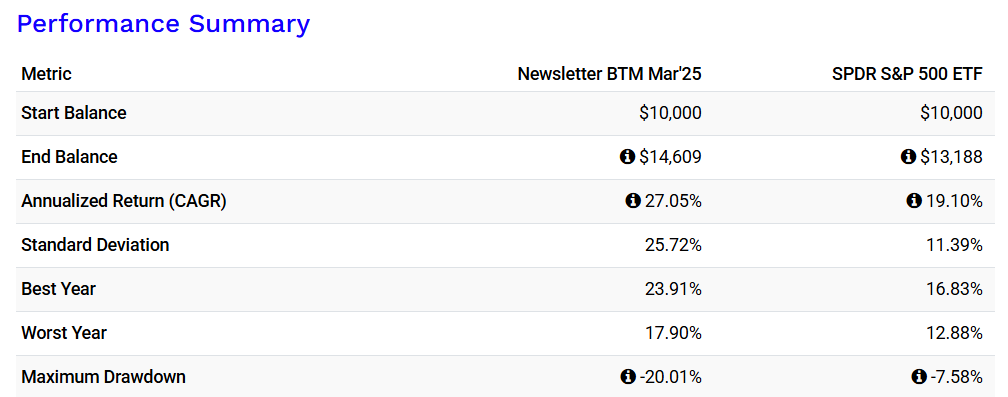This Newsletter Portfolio is Still Killing the Market
- Subscribe to my YouTube Channel HERE.
One of the big things this Newsletter is focused on is tracking strategies that work over time.
There are now a LOT of YouTube channels that focus on new, fun ideas -- that no one really follows up on.
Like Seinfeld said, "Anyone can take a reservation. It's the holding on to the reservation that matters."
And anyone can throw out an uncommitted idea to try to get clicks.
It's the tracking of the idea that matters.
At least, it's what matters to me.
So, not surprisingly, we go back and look at old strategies quite a bit.
For one, it lets us know what really works.
For another, it lets us know what doesn't work.
And, over time, the goal is that you or I could say, "Well, that's worked for a while. Maybe it's time to get involved."
To that end, today we're going to talk about an old portfolio that was mentioned back on March 15, 2024.
It's a stock portfolio and we're not trading it. Could we trade it? Sure.
But I want this to be as easy as possible.
I want to know about portfolios I can enter once on my phone or computer and not worry about them again for a long time.
And I want them to make more money than an index fund.
Back in 2024, today's portfolio seemed like a no-brainer because it incorporates leveraged instruments.
If we use leveraged ETFs, we should beat the market.
Right?
It only makes sense.
And has this portfolio beaten the market since March 2024 (with all three are equally-weighted)?
First, here's what's inside of it:

Here's how it's done for that past year and a half:


On the top is the testing software. And as you can see, the portfolio is still beating the market handily.
The bottom image is the same portfolio being tracked in real-time by me.
They both paint the same picture.
The Newsletter portfolio makes a lot more money than an index fund or ETF does.
But there are obviously questions.
One, what about McDonald's (MCD)? What's that doing in there? It was added for a few reasons: to provide stability against the leveraged instruments and to provide a small, growing dividend stream.
Has it worked?
Kind of.
By adding MCD, the max drawdown over this time period drops from 30% to 20%. That's a lot less drawdown--which means a lot less pain.
Which, of course, leads us to the other potential problem: this portfolio has bigger drawdowns.
Looking back up at the graphic, SPY's max drawdown was 7% while the Newsletter Portfolio's drawdown was 3x that.
So, on a "risk-adjusted" basis, SPY wins.
Is that a good line of thinking, though? It sure sounds smart.
But at the end of the eighteen months, what do we want at that moment?
Do we want to look back and say, "Boy, we had a respectable amount of drawdown!"
Or do we want more money to actually be able to use in our lives?
I'm very much focused on how to use trading and investing to change lives on an everyday basis.
I'm tired of theories about thirty years from now.
I want money I can actually use.
And this portfolio, as expected, absolutely would give me more money.
Plus, if I didn't look at the portfolio every second, the drawdown wouldn't even be noticed and would not be a factor.
Just something to consider.
The battle between usable money and drawdown worries is one that traders must concretely decide for themselves.
Talk to you soon.
DISCLAIMER: This is not financial advice.
It should not be assumed that the methods, techniques, or indicators presented in these videos will be profitable or that they will not result in losses. Past results are not necessarily indicative of future results. Examples presented are for educational purposes only. These set-ups are not solicitations of any order to buy or sell. The authors, the publisher, and all affiliates assume no responsibility for your trading results. There is a high degree of risk in trading. HYPOTHETICAL OR SIMULATED PERFORMANCE RESULTS HAVE CERTAIN INHERENT LIMITATIONS. UNLIKE AN ACTUAL PERFORMANCE RECORD, SIMULATED RESULTS DO NOT REPRESENT ACTUAL TRADING. ALSO, SINCE THE TRADES HAVE NOT ACTUALLY BEEN EXECUTED, THE RESULTS MAY HAVE UNDER- OR OVER-COMPENSATED FOR THE IMPACT, IF ANY, OF CERTAIN MARKET FACTORS, SUCH AS LACK OF LIQUIDITY. SIMULATED TRADING PROGRAMS IN GENERAL ARE ALSO SUBJECT TO THE FACT THAT THEY ARE DESIGNED WITH THE BENEFIT OF HINDSIGHT. NO REPRESENTATION IS BEING MADE THAT ANY ACCOUNT WILL OR IS LIKELY TO ACHIEVE PROFITS OR LOSSES SIMILAR TO THOSE SHOWN.



